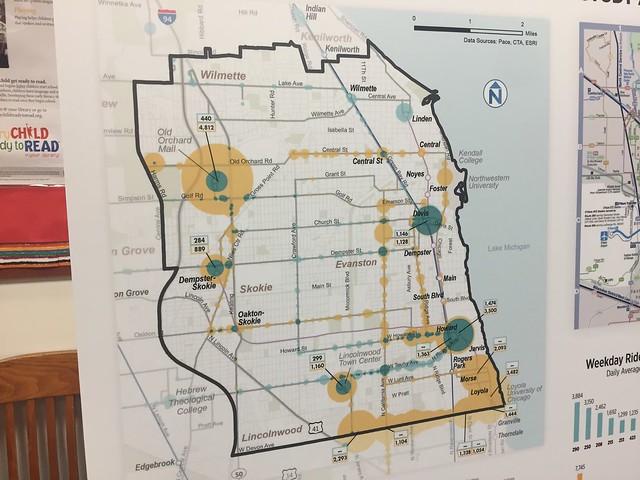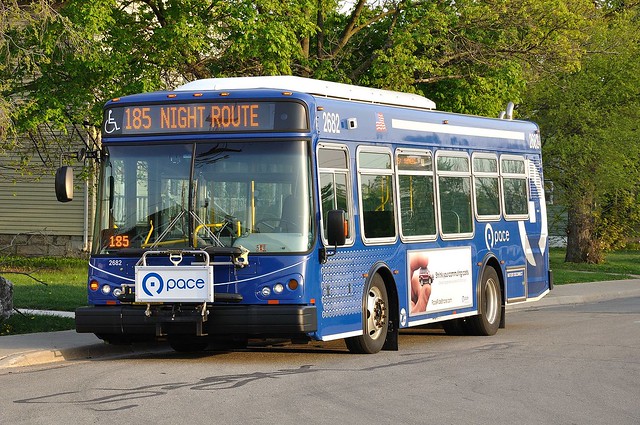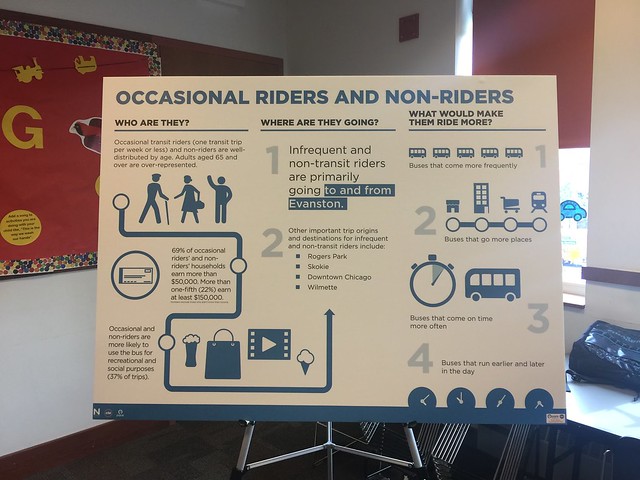CTA and Pace Brainstorm Ways to Improve North Shore Transit Service
3:19 PM CDT on October 11, 2016
Two transit agencies working toward a common goal is unfortunately a rare phenomenon in our country. Thankfully this has not stopped the CTA and Pace from joining forces to brainstorm ways to improve public transportation in the Chicago region.
The two agencies, with assistance from NelsonNygaard Consulting Associates, are currently working on the North Shore Transit Coordination Plan, a comprehensive study of the northern edge of the city and the near-north suburbs primarily focused on improving the bus service of both agencies. The goal of the study is to develop a list of recommendations and a plan for the agencies to execute in the near future. Last week CTA and Pace held an open house in Rogers Park to show area residents what they’ve been working on. The results of the study are both expected and surprising.
During the event, I first took a quick trip around the room looking at all the information boards they had up. The first board featured a very promising Project Purpose stating, “The purpose of this plan is to improve the coordination of CTA and PACE services by better understanding existing travel demands and transit markets while leveraging changes in communities and transit investments since the last major service revision in that area.” The board also included a project timeline and study area, including territory in Rogers Park, West Ridge, Lincolnwood, Skokie, Evanston, Wilmette, and Kenilworth, showcasing the many towns, bus routes, and rail lines included in the study itself.
The next board was an overview of current bus service with stop-level ridership and a zoomed in version of the main RTA map showing the area in context with the surrounding landscape along with several performance indicating charts. Unsurprisingly, terminals like Old Orchard Mall, the Davis Street CTA and Metra stations, and the CTA’s Howard stop dominated the stop-level ridership, with between 2,000 and 5,000-plus boardings.
The third board was on demographics and travel patterns. It featured surprising info about the number of people moving into the study area instead of out of it. By an almost two-to-one ratio, more users entered the zone than left it for places like downtown Chicago. This is extremely important to highlight as it emphasizes the need for more investment in outlying urban and nearby suburban bus service.
The next two boards reiterated the CTA/PACE ridership survey and a study-specific drilldown on occasional riders. Several facts stood out. For example, 50 percent of riders are between 18 and 40 years old, rith a disproportionate number of riders aged 18-24. However, in the “occasional rider” breakdown, there are a disproportionate number of adults aged 65 and over. Evanston was also singled out as the primary destination that people are going to and from with even downtown Chicago taking a back seat. The final interesting fact was that frequency was considered the most important factor in increasing ridership while additional destinations beat out both on-time performance and extending service hours.

The final board asked people to put down what aspect of transit service they think is most important. These were Efficiency & Connectivity, Frequency, and Speed & Reliability. Efficiency & Connectivity involved reduction in duplication, reallocating under-performing service to high demand areas, eliminating unnecessary transfers by re-routing service, and maintaining system coverage. Frequency was defined by less wait time between trips, high-quality service like Pace’s in-development Dempster line, concentrating improvements on routes where ridership is high, and benefits to all trip types throughout the day. Finally, Speed & Reliability talked about better on-time performance, dependable transfer opportunities, and focusing improvements on key corridors with current and future Pace Pulse “arterial rapid transit” service.
After studying the boards, I had a chance to chat with a representative of Pace about the service. Right off the bat we started talking about possible improvements for the corridors. For instance, bus rapid transit is very much seen as a next step for some routes. These are likely to be modeled after Pace’s Pulse routes with the Milwaukee line coming into service in 2017 and the Dempster line in 2019-2020. That said, dedicated lanes and pre-paid boarding are still a possibility for these routes if the ridership and streetscape can support it.
We also talked about possible heavy rail solutions. Sadly, the study’s scope doesn’t cover rail-based solutions and even if the study does make recommendations, any significant improvements would need a more detailed and focused study. However, smaller things such as minor station upgrades and better-timed transfers could very much be in the cards. Metra was also briefly talked about, but unfortunately in this study the commuter rail agency is relegated to stakeholder status, rather than being a lead agency, so coordination with Metra is limited in the study scope. It’s also worth mentioning that most of these projects would potentially require much more funding than CTA and Pace can afford.
Another big thing we talked about were the quickly changing commuting patterns. The study has looked into everything from routes coming into the area, to reverse commuting, and suburb-to-suburb movements. According to their data all three groups are experiencing growth with east-west travel growing faster than current Chicago Metropolitan Agency for Planning projections. That said, I was reminded that a significant number of these new riders are heavily tied to industry locations and heavily reliant on job numbers. On the other hand, these are not the only new users.
Occasional users are another growing population. Many of these users are older and travel within one to two transfers. This is seen as a very important demographic to both agencies with a strong desire to make service more attractive to these users. This could be done with simple things like speeding up service, more direct service, and less confusing service. Probably the biggest possible change is the potential for the CTA and Pace to switch branding on select routes. This would open the door to a total restructuring of the area with a more robust grid of bus lines tailored to the needs of more people.
This brings me to overarching theme of our conversation: unity between the agencies. It was made abundantly clear to me that this truly is a quest for improvement rather than a petty squabble over who will get the higher ridership routes. As this process continues we should, as a region, continue to encourage this kind of cooperation. We should not allow the types of inter-agency conflicts that prevent progress from prevailing.
To wrap up our conversation, I asked how the Ventra payment system was playing a role in the study and the answer was very interesting. Ventra has enabled both agencies to get a much more in-depth analysis of ridership. They can now track transfers far more accurately and quickly than before to build a profile of route users. It was also confirmed in a follow-up email that current usage of Ventra is hovering around 75-80 percent with the remaining riders using cash. This should instill confidence in the study’s results.
A few odds and ends we talked about included transit-oriented development that is confirmed to be on the table but would most likely require zoning changes in most of the study area. Another interesting point was the idea of keeping persuasive information at a semi-slow drip to change hearts and minds over time rather than risk overwhelming residents with data.
As for next steps I was reminded that the Pace website makeover is in the pipeline and on track for a rollout next year. Also coming next year should be the preliminary alternatives at the next open house on a still to be determined date. Finally, the planners want as much feedback as possible and highly encourage people to leave comments on the website.
Stay in touch
Sign up for our free newsletter
More from Streetsblog Chicago
The de-facto ban on riverwalk biking is back. What should we do about it?
In the short term, new signage is needed to designate legal areas for cycling on the path. In the long term CDOT should build the proposed Wacker Drive protected bike lane.
Today’s Headlines for Thursday, April 25
It’s electric! New Divvy stations will be able to charge docked e-bikes, scooters when they’re connected to the power grid
The new stations are supposed to be easier to use and more environmentally friendly than old-school stations.







